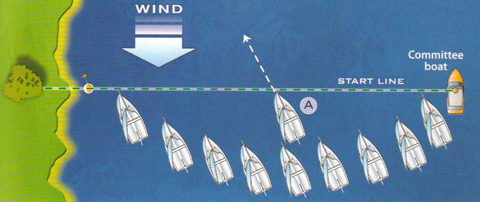
Cruiser Racing part 8 - the start line
Know where the best possible place is on the start line.
Knowing the best possible place to start on a line will help you sail away from the fleet and be first round the windward mark.
Although all races vary in length and course, the start line will usually be positioned to give boats a dead beat to the first mark.
The start line is usually between a committee boat and a buoy. The race committee will always try to ensure that the start line is exactly 90° to the wind, so that the first mark is directly to windward.
This makes it simpler for boats to adjust their pace as they approach the line and allows the fleet to separate quickly as they tack towards the first mark. If the start line is set at this angle, most boats will start on a starboard tack to have right of way.
Bias
However the wind can shift between laying the course and the start gun, meaning the start line will often not be exactly 90°s to the wind.
This means there will be an advantage of being at one end of the line because the first mark is a shorter distance or reached more easily on a certain tack - this is called a line bias.
On occasions the committee boat may position itself at the starboard end of the start line and may plan a line bias to port, encouraging boats to start on starboard tack and sail away from the committee boat.
If you have a downwind start, the favoured end will be the one that is more downwind. To determine which end is more downwind, use the same technique as an upwind start

Line sag
It is easier to judge if you are on the start line when starting close to the starting buoy or the committee boat. But for boats in the centre the line it is harder to judge and there is a tendency to hang back in a curve so it seems as if the line is sagging.
To combat line sag and to help you get a good start on the centre of the line, you should find a transit. To get a transit, sail to one end of the line and look through the committee boat to the buoy and pick a distinctive object – church steeple, line of trees, etc.
When approaching the start line, keep an eye on the transit to give you an idea of your position. Remember to take into account the effect of any tide as well.

Crew A have used the tree and buoy in transit to identify when their bow is on the line whilst the other boats sag on the line.
Fixed start lines
Sometimes a fixed start line, such as a clubhouse or a starting box in the water is used. Although course starts are usually set into the wind, if navigational marks are used as racing marks the first leg of the course may not be a beat.
If there are boats to windward of you on the start line your sail set will be affected by dirty air as it comes off their sails. As soon as you can, tack away to get yourself into clean air which will allow you to sail faster.
Boat speed and control
An important factor in getting a good start is to cross the line as the gun goes, with the boat up to speed. It is important to control your boat speed and position during the last minute before your start.
With a minute to go, try to get roughly in position on the line but some distance back. Use your sails to control your speed, spilling wind to stop yourself heading to the line too quickly.
It’s only worth sitting nearly on the line in virtually no wind, otherwise hang back. When you’re at the 10 second countdown, sheet in and go for the line.

America’s cup World Series Multihulls controlling their speed before the start, then power on and across the line.
Words & pictures: Simon and Vicky Jinks, SeaRegs Training.©SeaRegs2012
Illustrations: Pete Galvin from RYA Start to Race publication